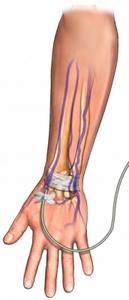Transfusion of blood and blood products
Description of the procedure of blood transfusion
Blood transfusion – delivery of blood products through a vein. Blood products may be red cells, leukocytes, platelets, coagulation factors, plasma or normal blood.

It can be used blood from an unrelated donor or relative, or received in advance, and stored in special conditions.
Causes of Blood Transfusion
Blood transfusion should help increase the level of blood cells or other blood components. This may be necessary if the patient had the following medical problems:
- Blood loss due to injury, surgery, or disease;
- Severe anemia;
- Diseases of the circulatory system, such as von Willebrand's disease and haemophilia;
- Problems of the immune system;
- Leukemia;
- Disease, which lead to the destruction of blood cells or bone marrow;
- Side effects of some medications (eg, Cancer chemotherapy).
Possible complications of blood transfusion
Complications from a blood transfusion are rare, may include:
- Allergic reactions due to mismatched blood composition – rarely;
- Certain infections, such as hepatitis or HIV, It can be transmitted during a blood transfusion, but it happens very rarely. Conduct ongoing research and analysis, to test donated blood for infections, before entering to the patient.
How is blood transfusion?
Prior to the blood transfusion
- Analyzing blood, to identify the group, and other blood parameters. Donated blood will be carefully matched by blood group;
- Also performed a medical examination. Recorded vital signs (eg, temperature, heart rate, respiration rate, blood pressure);
- Before a blood transfusion to a patient may be given Tylenol (paracetamol) and Benadryl (dimedrol), before performing a blood transfusion. These drugs will help reduce some allergic reactions.
Description of the procedure of blood transfusion
The patient will be asked to sit in a special chair. The capacity of the blood or the product will be hung next.
In the vein of the hand or wrist is introduced around the needle. The drug is the blood will slowly, dropwise, fed from the tank through the tube into the vein. As soon as the container becomes empty, the needle is removed from the vein.
Throughout the time of transfusion monitored vital parameters. If you feel pain, itching, discomfort or negative feelings you should immediately inform your doctor. The majority of adverse reactions occur at the beginning of blood transfusion, but the vital signs will be monitored for 15 minutes after treatment.
How long does it take a blood transfusion?
About 2-4 hours
Blood transfusion – will it hurt?
Insert the needle into the vein can cause a little pain. Once the needle is in place, it should not cause pain.
Caring for the patient after blood transfusion
In the hospital
Immediately after the procedure, the staff may provide the following assistance:
- A nurse will monitor the vital signs;
- Your doctor may give you specific instructions based on the overall condition of the patient;
- Your doctor may order a blood test, to determine, how effective the transfusion was.
Nursing homes
After returning home from a blood transfusion is necessary to carefully follow the doctor's advice in respect of any activities, limiting it in accordance with the instructions.
It is necessary to go to the hospital in the following cases
After arriving home immediately to contact a doctor if there are any symptoms of an allergic reaction or infection, such as:
- Rash, hives, or itching;
- Swelling in the legs, hands, kistyah or person;
- Dizziness;
- Nausea and / or vomiting;
- Pain, especially in the back or chest;
- Breathlessness, wheeze;
- Symptoms of infection, including fever and chills;
- Krasnoja, naʙuxanie, increased pain, excessive bleeding, or swelling at the injection needle.
In the case of severe state should immediately call an ambulance.
